Hey there! If you’re dreaming of turquoise waters, sun-kissed beaches, and ancient ruins perched on dramatic cliffs, Greece’s islands are calling your name. As someone who’s hopped from one idyllic spot to another across the Aegean and Ionian Seas, I can tell you firsthand that these islands offer a perfect blend of natural beauty, history, and laid-back vibes.
But with over 6,000 islands (only about 227 inhabited), planning your first trip can feel overwhelming. That’s why I’ve put together this comprehensive guide—tailored specifically for first-timers like you who want practical advice to make your adventure seamless and unforgettable.
In this article, we’ll dive into the most beautiful islands, from the iconic volcanic landscapes of Santorini to lesser-known gems like Tinos. I’ll share must-see spots, the best times to visit, how to get around, recommended stay durations, and tips on everything from hiring a driver to respecting local customs. Think of this as your all-in-one roadmap to confidently plan and enjoy your Greek island escape. Let’s get started!
Why Visit the Greek Islands? An Overview for Beginners
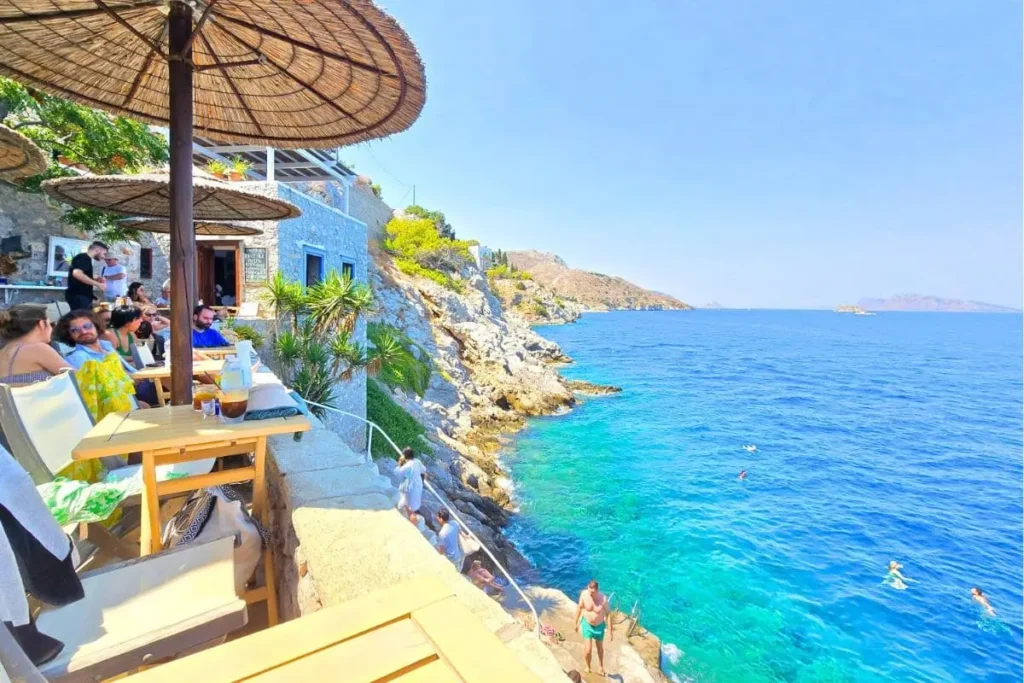
Greece’s islands are a mosaic of stunning landscapes—think whitewashed villages tumbling down hillsides, hidden coves with crystal-clear waters, and olive groves whispering in the breeze. What makes them so special? Their diversity. You can chase sunsets in the Cyclades, hike volcanic trails in the Dodecanese, or unwind on sandy beaches in the Ionian group. For first-timers, the beauty lies in the accessibility: most are just a ferry ride from Athens, and they cater to all budgets, from backpacker hostels to luxury villas.
But beauty comes with crowds, especially in peak season. That’s why planning ahead is key. I’ve visited during bustling summers and serene shoulders, and trust me, the right timing and prep can turn a good trip into a magical one. Expect fresh seafood tavernas, warm hospitality, and moments where you feel like you’ve stepped into a postcard. Pro tip: Pack light layers, reef-safe sunscreen, and comfortable walking shoes—the islands involve a lot of steps and uneven paths!
Best Time to Visit the Greek Islands
Timing your trip is crucial for first-time visitors, as it affects everything from weather to crowds and prices. Greece’s islands enjoy a Mediterranean climate: hot, dry summers and mild, wet winters. Here’s a breakdown to help you decide:
High Season (June to August):
This is prime time for beauty at its peak—endless sunshine (up to 14 hours a day), warm seas (around 25°C/77°F), and vibrant festivals. Islands like Mykonos and Santorini glow under blue skies, but expect packed beaches and higher costs (hotels can double in price). If you’re after lively vibes and perfect swimming weather, go for it—but book ferries and accommodations months in advance. I once arrived in July without a reservation and ended up paying a premium for a basic room.
Shoulder Seasons (May, September to October):
My personal favorite for first-timers. Temperatures hover around 20-28°C (68-82°F), waters are still swimmable, and crowds thin out. Prices drop by 20-50%, and you get that golden-hour light for photos without the heat haze. September is ideal for hiking on islands like Crete, as the wildflowers bloom post-summer. Avoid early May if you’re sensitive to cooler evenings.
Low Season (November to April):
For budget travelers or those seeking solitude, this is when islands reveal a quieter beauty—think stormy seas crashing on cliffs and cozy tavernas by fireplaces. Many ferries reduce service, and some hotels close, but places like Rhodes stay mild (10-15°C/50-59°F). Christmas on Corfu or Easter on Patmos offers cultural immersion, but pack for rain.
Best overall? Late May to early June or mid-September for a balance of weather, affordability, and fewer tourists. Check ferry schedules via apps like Ferryhopper, as weather can cause delays. If you’re prone to seasickness, opt for calmer months.
How to Get to the Greek Islands: Transportation Basics
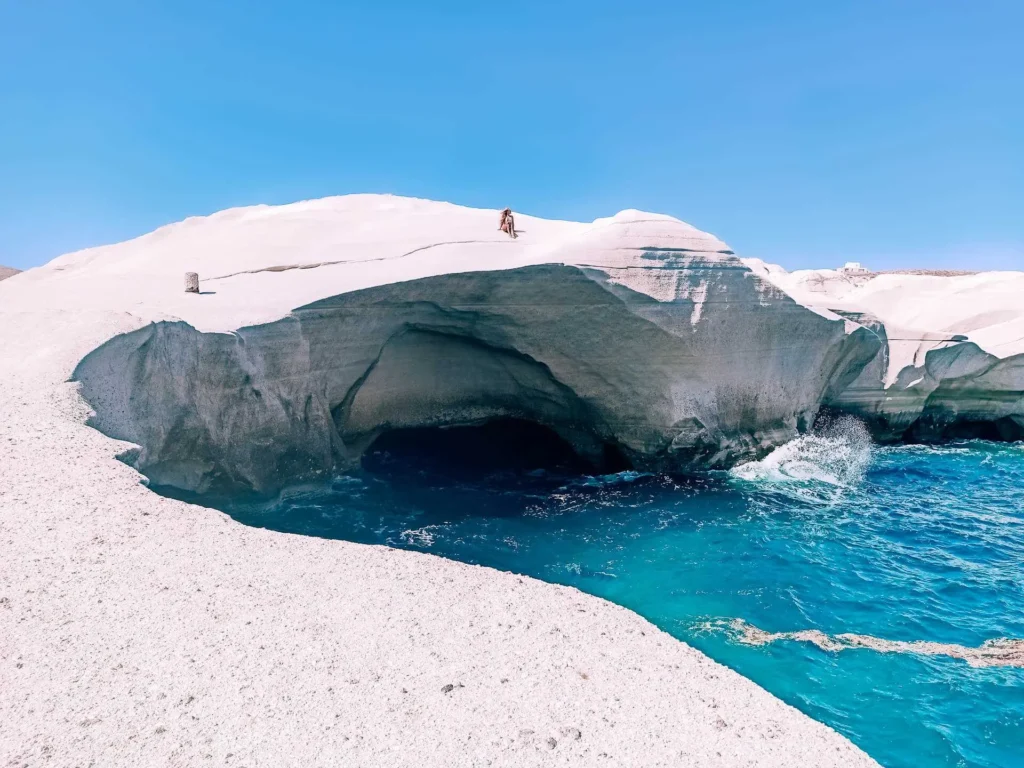
Reaching the islands is straightforward, but as a first-timer, you’ll want to mix flights and ferries for efficiency. Most journeys start in Athens (or Thessaloniki for northern islands).
- International Flights: Fly into Athens International Airport (ATH)—it’s a hub with direct connections from major cities worldwide. Budget airlines like Ryanair or EasyJet offer deals from Europe (under €50 one-way). From the US, expect 10-12 hour flights via Delta or United, costing $500-800 round-trip in shoulder season.
- Domestic Flights: For quicker access, hop a short flight from Athens. Airlines like Aegean or Olympic Air serve islands like Santorini (45 minutes, €50-100) or Crete (1 hour, €40-80). Book early for deals, and note baggage limits (usually 23kg checked).
- Ferries from Mainland Ports: The classic way! From Piraeus (Athens’ main port), ferries run daily. High-speed catamarans (2-4 hours to Cyclades) cost €40-70, while slower conventional ferries (4-8 hours) are cheaper (€20-50) but more scenic. Use Ferryscanner for real-time bookings. From Rafina (closer to the airport) or Lavrio, you can reach eastern Cyclades faster.
Once on the islands, transportation varies—more on that below. Pro tip: If flying domestically, arrive early; Greek airports can be chaotic. For eco-conscious travelers, ferries have a lower carbon footprint.
Island Hopping: Getting Around and Between Islands
Island hopping is the heart of a Greek adventure, but navigation takes planning. Ferries connect most islands, but schedules are seasonal. Here’s how to do it right:
- Ferries and Hydrofoils: Main operators like Blue Star, SeaJets, or Hellenic Seaways offer routes. For example, from Mykonos to Santorini: 2-3 hours, €50-80. Book online and print tickets—digital ones sometimes glitch. In high season, ferries sell out; aim for morning departures to avoid rough seas.
- Domestic Flights Between Islands: Limited but handy for longer jumps, like Crete to Rhodes (1 hour, €60-100 via Sky Express). Not all islands have airports (e.g., no direct from Hydra).
- Private Boats or Charters: For flexibility, rent a speedboat (€100-300/day) or join group tours. Ideal for hidden coves on islands like Milos.
On-island transport:
- Scooters and ATVs: Rent for €20-40/day—perfect for hilly terrain like Naxos. Wear helmets (mandatory) and drive cautiously; roads can be winding.
- Cars: €30-60/day for freedom on larger islands like Crete. International driver’s license recommended.
- Buses and Taxis: Cheap buses (€2-5) on touristy islands; taxis €10-20 for short rides. Apps like Beat work in bigger spots.
- Walking and Cycling: Free and scenic in small islands like Hydra (car-free!).
Tips for hiring a driver: On islands without public transport (e.g., Folegandros), hire a private driver or taxi for day tours (€50-100/half-day). Negotiate rates upfront, check reviews on TripAdvisor, and tip 10% for good service. For multi-day, opt for licensed guides via local tourism offices. Always confirm insurance.
Recommended hopping itinerary for first-timers: Start in Athens, ferry to Mykonos (3 days), then Santorini (4 days), end in Crete (5 days). Total: 2 weeks.
Top Most Beautiful Islands in Greece: Must-See Spots and Itineraries
Now, the stars of the show! I’ve selected 15 of the most beautiful islands, blending popular stunners with quieter beauties. For each, I’ll detail must-sees, recommended durations, and practical tips. These are based on my trips and blogger insights—focus on 3-5 for your first visit to avoid burnout.
1. Santorini: Volcanic Drama and Sunsets

Santorini’s caldera views are legendary—think white buildings clinging to red-black cliffs over the Aegean. It’s beauty personified, but crowded.
Must-See Places:
- Oia Village: Iconic blue-domed churches and sunset spots. Hike the caldera path for panoramas.
- Fira Town: Cable car rides, museums, and volcano views.
- Red Beach: Striking red sands and cliffs—swim in clear waters.
- Akrotiri Ruins: Ancient Minoan site, like Pompeii.
- Wineries: Taste Assyrtiko at Santo Wines.
Recommended Duration: 4-5 days. Spend 2 exploring villages, 1 on beaches, 1 on a boat tour.
Practical Tips: Best time: September for fewer crowds. Transport: Rent a scooter (€25/day) or use buses (€2). Dress code: Modest for churches (cover shoulders/knees). Respect customs: Don’t climb ruins; locals value quiet evenings.
2. Mykonos: Windmills and Party Vibes
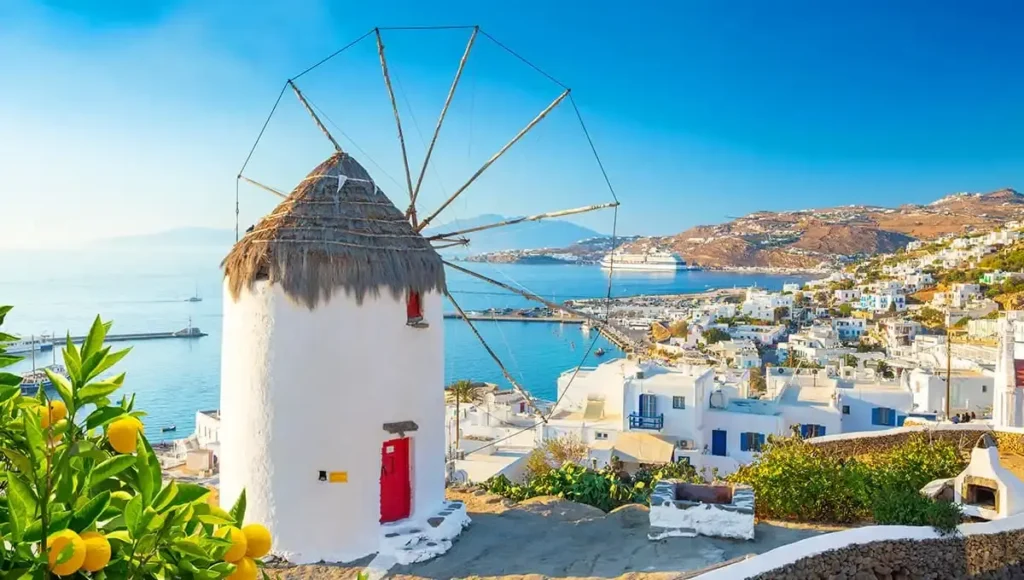
Mykonos dazzles with windmills, chic beaches, and nightlife, but its beauty shines in the labyrinthine streets and golden sands.
Must-See Places:
- Little Venice: Waterfront bars with waves lapping at your feet.
- Paraportiani Church: Sculptural white wonder.
- Paradise Beach: Lively sands with clubs.
- Delos Island: Day trip to ancient ruins (UNESCO site).
- Armenistis Lighthouse: Cliffside views.
Recommended Duration: 3-4 days. 1 for town wandering, 2 for beaches.
Practical Tips: Visit May for calmer scenes. Scooters or ATVs essential (€30/day). Hiring a driver: €80 for airport transfers. Customs: Beaches are relaxed, but cover up in town. Avoid peak party hours if seeking peace.
3. Crete: Mountains, Beaches, and History
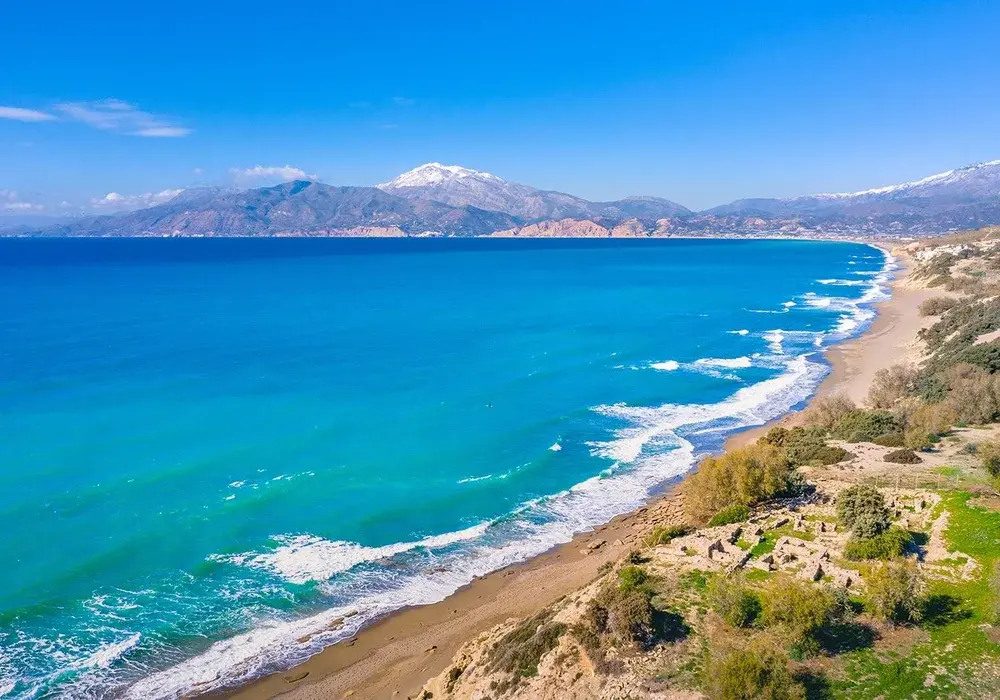
Greece’s largest island blends rugged gorges, pink sands, and Minoan palaces—pure, untamed beauty.
Must-See Places:
- Elafonissi Beach: Pink sands and lagoons.
- Knossos Palace: Mythical Minoan ruins.
- Samaria Gorge: 16km hike through dramatic canyons.
- Chania Old Town: Venetian harbor and markets.
- Balos Lagoon: Turquoise paradise (boat access).
Recommended Duration: 7-10 days. 3 in Chania, 2 hiking, 2 beaches.
Practical Tips: April-October best; rent a car (€40/day) for freedom. Driver tips: Hire for gorges (€100/day including guide). Dress: Sturdy shoes for hikes; modest for monasteries. Customs: Greet with “kalimera” (good morning); try local raki respectfully.
4. Rhodes: Medieval Charm and Sandy Shores
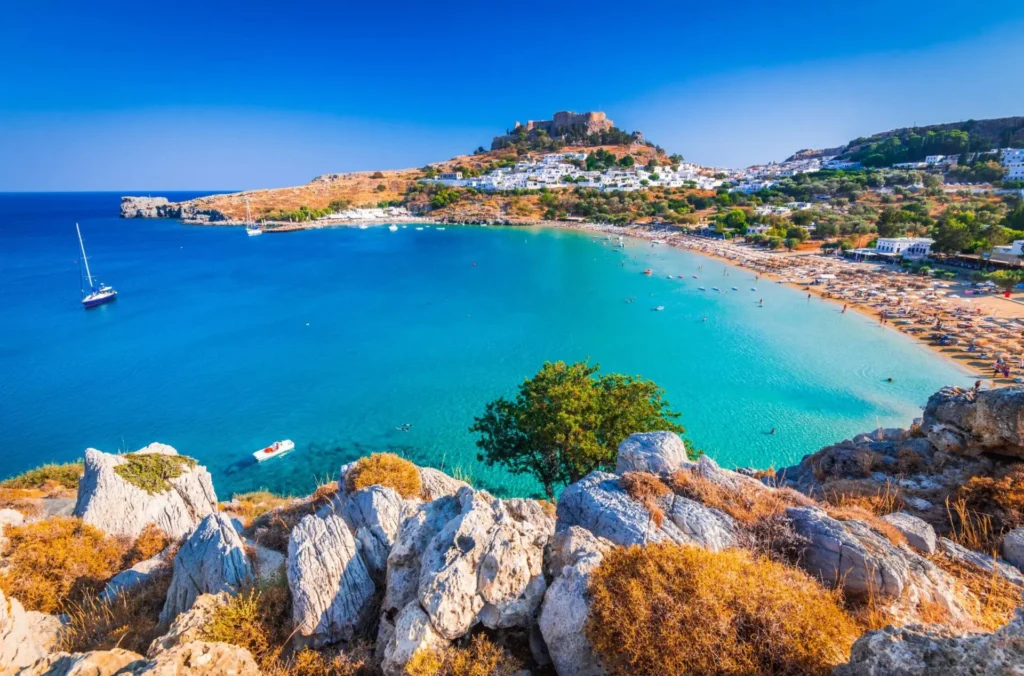
Rhodes’ Old Town walls and pebble beaches offer medieval beauty with a sunny twist.
Must-See Places:
- Medieval City: UNESCO walls, Palace of Grand Masters.
- Lindos Acropolis: Cliff-top temple overlooking bays.
- Anthony Quinn Bay: Rocky cove for snorkeling.
- Valley of Butterflies: Lush nature reserve.
- Faliraki Beach: Long sands.
Recommended Duration: 5-7 days. 2 in Old Town, 2 beaches, 1 excursions.
Practical Tips: June-September ideal. Buses efficient (€3-5); hire driver for remote spots (€60/half-day). Customs: Cover up in religious sites; respect quiet hours (siesta 2-5pm).
5. Corfu: Green Hills and Ionian Blues
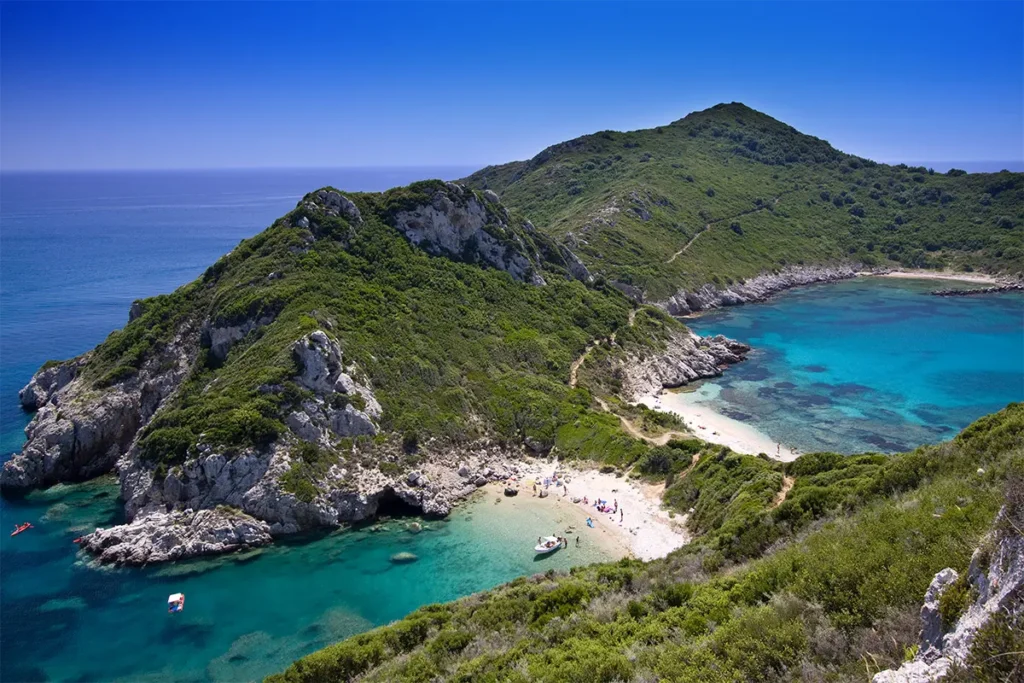
Lush and elegant, Corfu’s olive groves and Venetian fortresses create a verdant beauty.
Must-See Places:
- Old Town: Liston Arcade and fortresses.
- Paleokastritsa: Monastery and beaches.
- Canal d’Amour: Dramatic rock formations.
- Achilleion Palace: Sissi’s summer home.
- Sidari Beach: Sandy cliffs.
Recommended Duration: 4-6 days. 2 town, 2 beaches.
Practical Tips: May-October; rent car for hills (€35/day). Driver: €70 for tours. Dress: Casual, but modest for monasteries.
6. Milos: Volcanic Beaches and Lunar Landscapes

Milos’ colorful sands and moon-like rocks are otherworldly beautiful.
Must-See Places:
- Sarakiniko Beach: White volcanic formations.
- Kleftiko Caves: Boat-accessible sea arches.
- Plaka Village: Sunset views.
- Venus de Milo Site: Ancient statue origin.
- Firopotamos Beach: Quiet pebbles.
Recommended Duration: 4 days. 2 beaches, 1 boat tour.
Practical Tips: June-September; ATVs handy (€25/day). Customs: No drones near sites.
7. Naxos: Fertile Valleys and Giant Statues
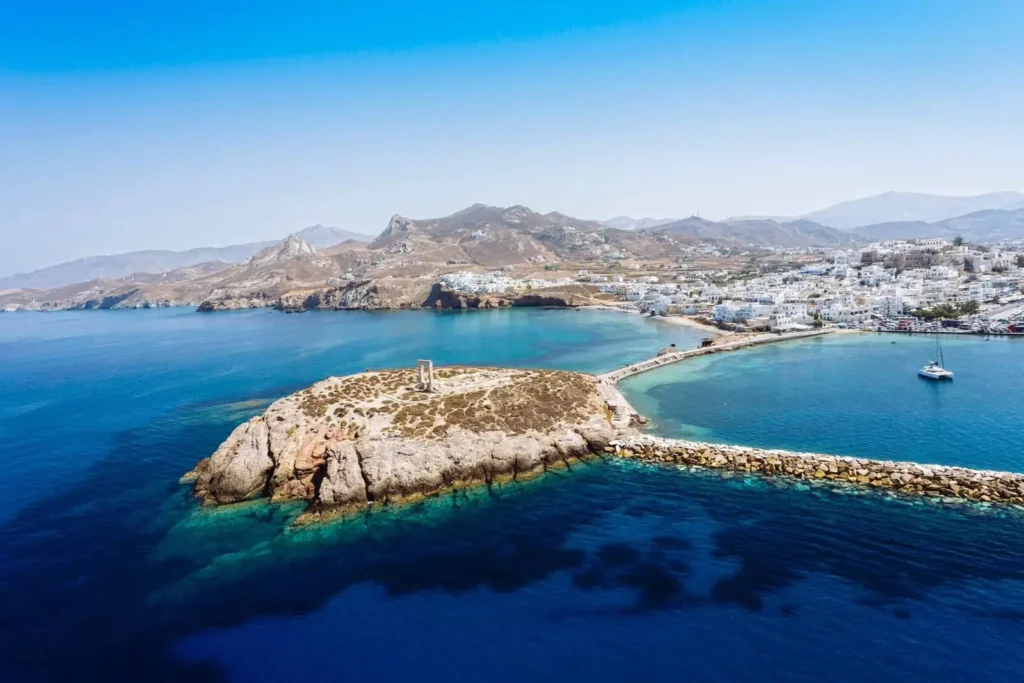
Naxos blends beaches, mountains, and ancient kouroi for rustic beauty.
Must-See Places:
- Portara: Apollo’s massive gate.
- Agios Prokopios Beach: Golden sands.
- Halki Village: Byzantine churches.
- Mount Zas: Hike to Zeus’s cave.
- Apeiranthos: Marble village.
Recommended Duration: 5 days.
Practical Tips: Scooter rental; respect farming areas.
8. Paros: Golden Beaches and White Villages
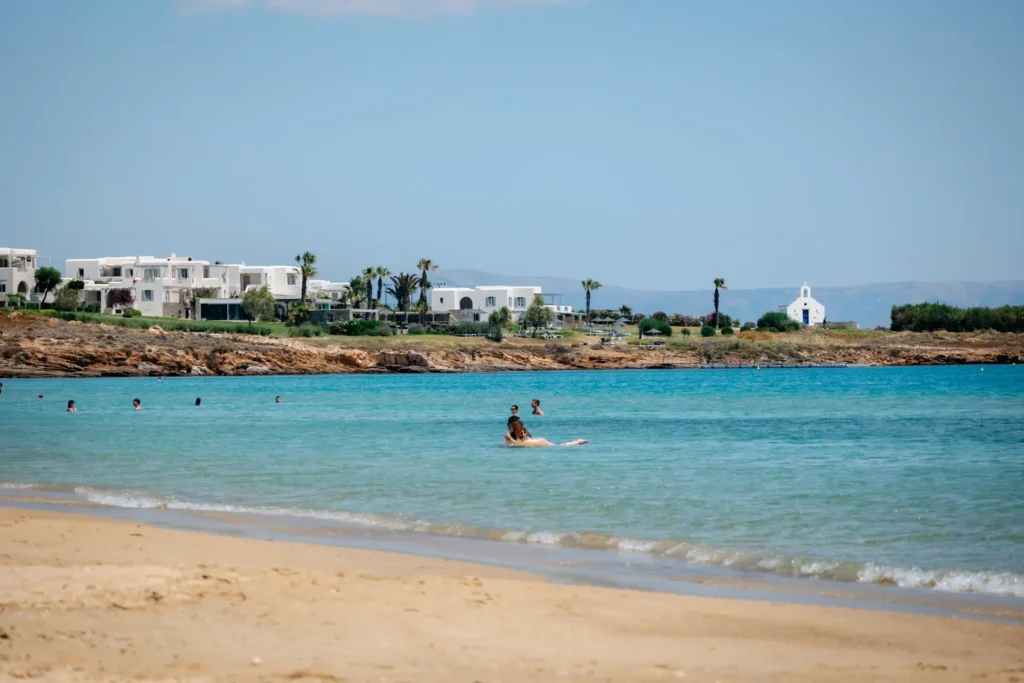
Paros’ windswept beauty shines in its bays and quarries.
Must-See Places:
- Naoussa Harbor: Fishing vibes.
- Kolymbithres Beach: Rock pools.
- Lefkes Village: Mountain trails.
- Panagia Ekatontapiliani: Ancient church.
- Golden Beach: Windsurfing spot.
Recommended Duration: 4 days.
Practical Tips: Buses good; modest dress in churches.
9. Hydra: Car-Free Serenity and Rocky Coasts

Hydra’s donkey paths and mansion-lined harbor offer timeless beauty.
Must-See Places:
- Harbor Promenade: Sunset walks.
- Kamini Beach: Pebble cove.
- Profitis Ilias Monastery: Hike up.
- Historical Archives Museum.
- Vlychos Beach: Boat access.
Recommended Duration: 3 days.
Practical Tips: Walking only; water taxis €10-20.
10. Tinos: Dovecotes and Sacred Sites
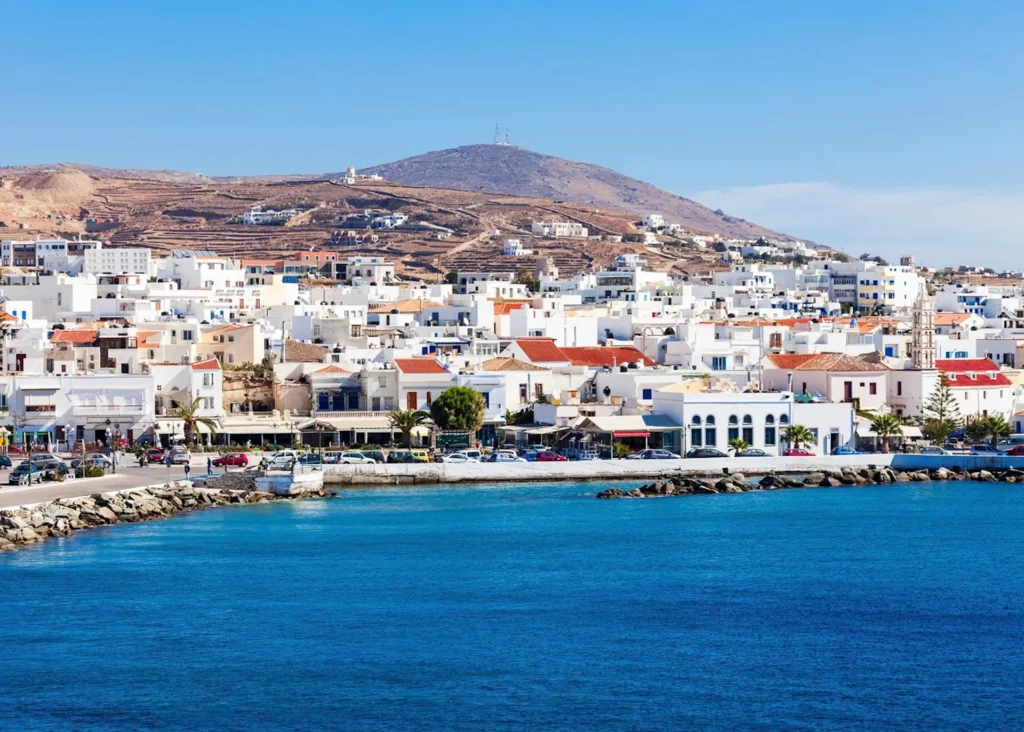
Tinos’ rugged hills and marble villages are quietly stunning.
Must-See Places:
- Pyrgos Village: Marble art.
- Volax: Boulder landscapes.
- Church of Panagia: Pilgrimage site.
- Kolibithra Beach: Windswept sands.
- Dovecotes Trail: Scenic hike.
Recommended Duration: 4 days.
Practical Tips: Rent car; cover for church (women: skirts).
11. Paxos: Olive Groves and Azure Caves
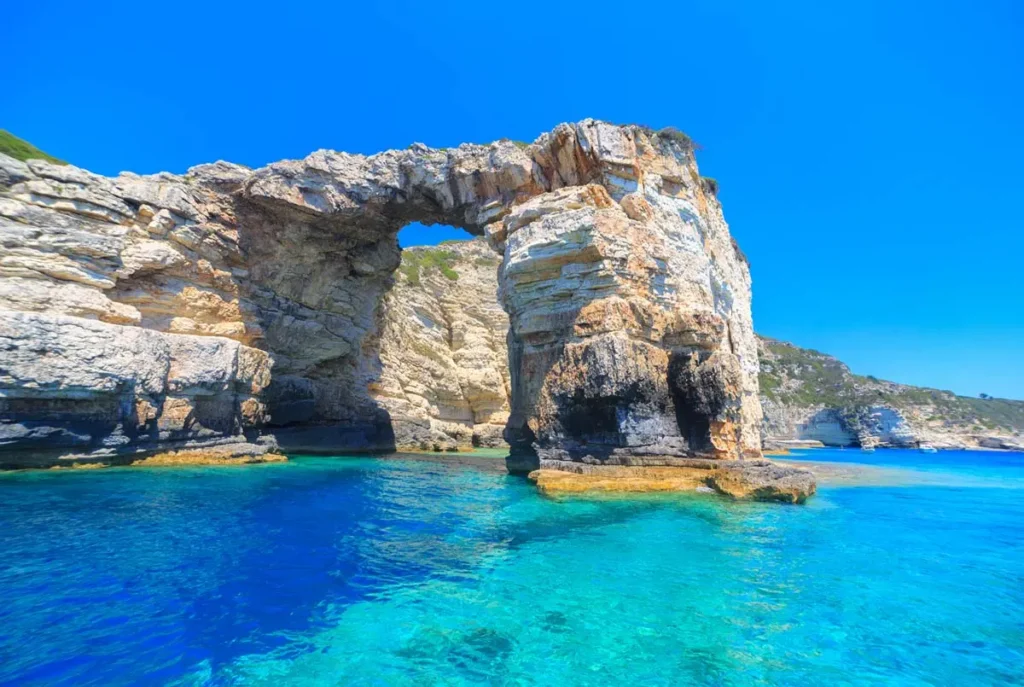
Tiny Paxos’ cliffs and coves are Ionian perfection.
Must-See Places:
- Gaios Town: Waterfront charm.
- Tripitos Arch: Natural wonder.
- Lakka Bay: Sandy beach.
- Anti-Paxos: Swim spots.
- Erimitis Cliffs: Sunsets.
Recommended Duration: 3 days.
Practical Tips: Boat tours essential.
12. Lemnos: Volcanic Dunes and Flamingo Lakes
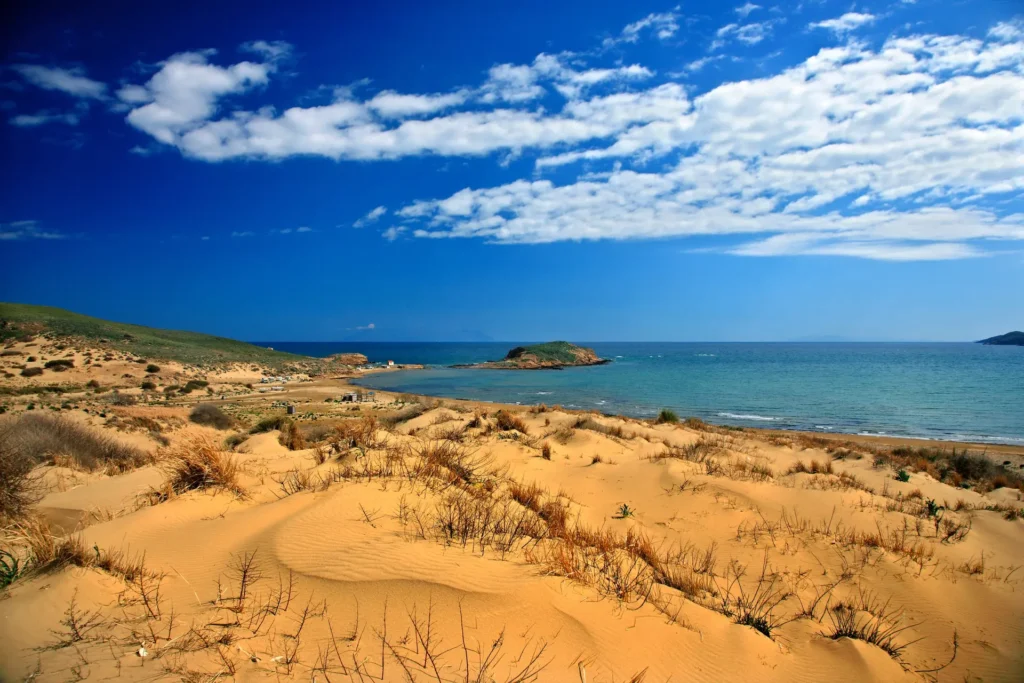
Lemnos’ wild sands and lakes offer raw beauty.
Must-See Places:
- Myrina Town: Castle views.
- Pachies Ammoudies: Dunes.
- Keros Beach: Surfing.
- Aliki Lake: Birdwatching.
- Hephaestus Ruins.
Recommended Duration: 4 days.
Practical Tips: Car hire; respect nature reserves.
13. Folegandros: Cliff Trails and Hidden Bays
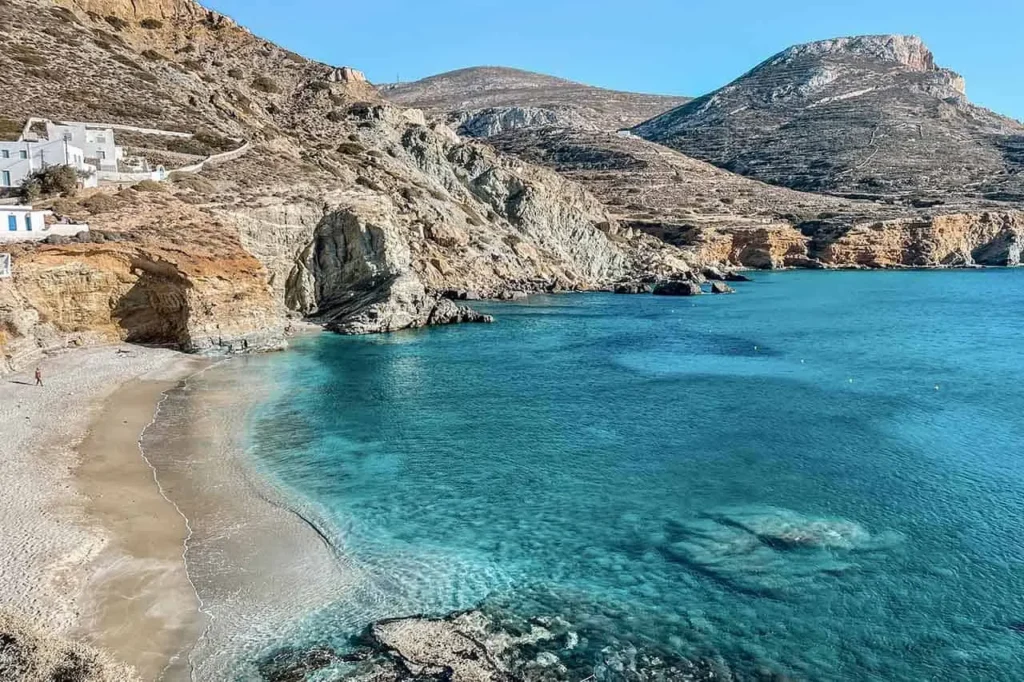
Folegandros’ stark cliffs and churches are poetic.
Must-See Places:
- Chora Town: Cliff-edge views.
- Angali Beach: Secluded sands.
- Panagia Church: Hike up.
- Katergo Beach: Boat only.
- Livadi Beach: Camping spot.
Recommended Duration: 3 days.
Practical Tips: Walking trails; modest attire.
14. Kimolos: Pristine Simplicity
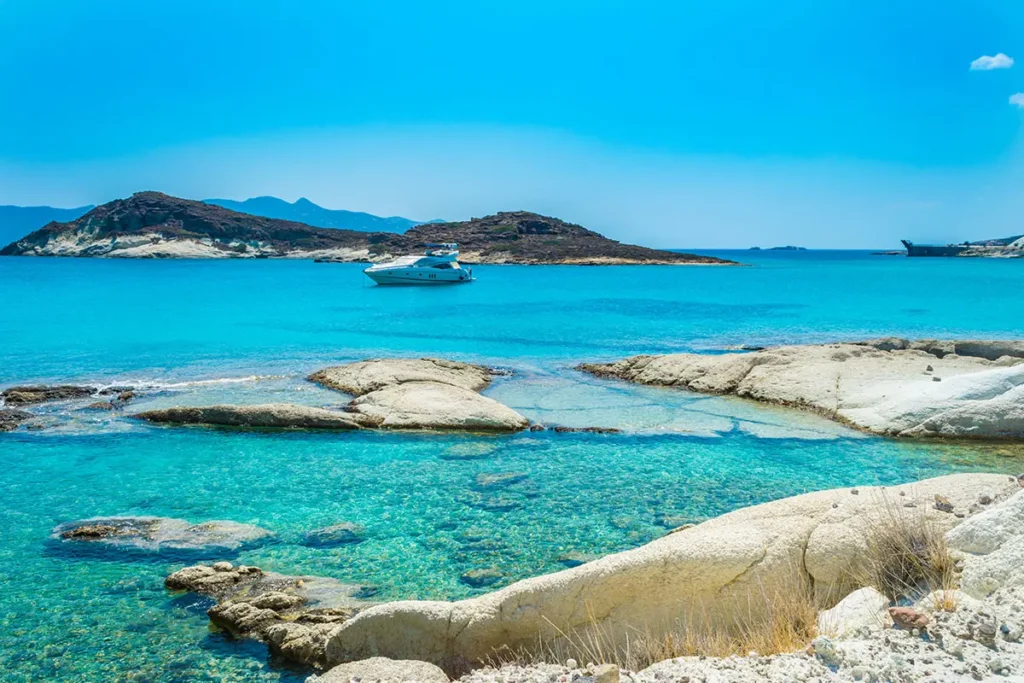
Kimolos’ white houses and beaches are unspoiled.
Must-See Places:
- Horio Village: Alleys and churches.
- Prassa Beach: Crystal waters.
- Medieval Castle.
- Skiadi Rock: Mushroom formation.
- Goupa Beach: Fishing huts.
Recommended Duration: 3 days.
Practical Tips: Ferry from Milos; quiet customs.
15. Sikinos: Starry Skies and Wineries
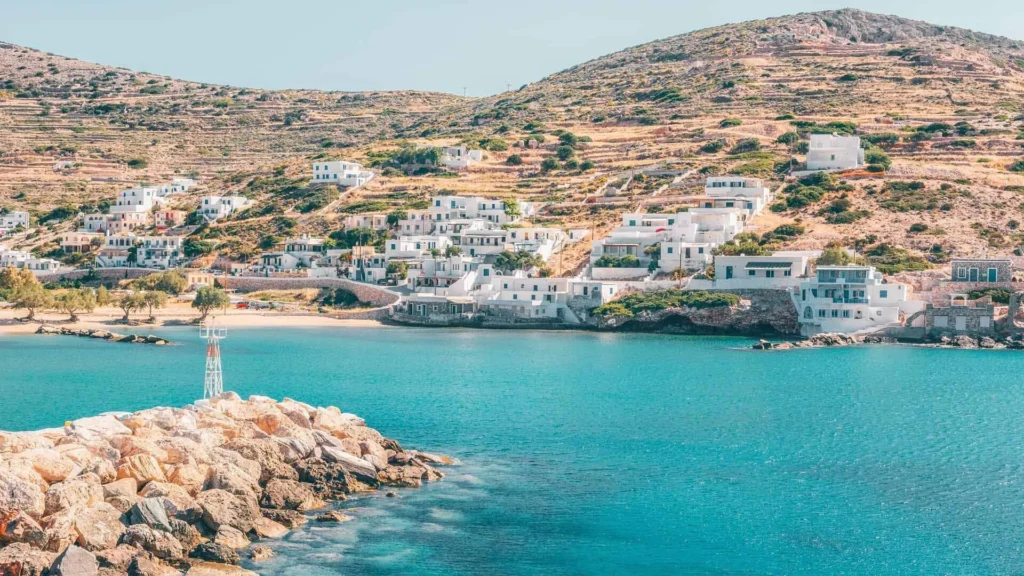
Sikinos’ simplicity highlights its natural allure.
Must-See Places:
- Chora Village: Sunset winery.
- Alopronia Port: Beaches.
- Episkopi Monastery: Ancient site.
- Agios Georgios Beach.
- Manali Winery: Tastings.
Recommended Duration: 2-3 days.
Practical Tips: Limited transport; hike respectfully.
Practical Tips for Planning Your First Greek Island Trip
- Budgeting: Expect €100-200/day including food (€20-40/meal), lodging (€50-150), and transport. Save with off-peak travel.
- Accommodations: Book via Booking.com—villas for groups, Airbnbs for authenticity.
- Food and Water: Tap water safe on most; try souvlaki, moussaka. Vegan options abound.
- Health and Safety: Sun protection key; EU citizens get free healthcare with EHIC.
- Connectivity: Free Wi-Fi widespread; get a local SIM (€10).
Respecting Local Customs and Dress Codes
Greeks are welcoming, but respect enhances your trip:
- Greetings: Handshakes or cheek kisses; say “efcharisto” (thank you).
- Dress Codes: Beaches: Bikinis fine, but cover for tavernas. Churches/Monasteries: Shoulders/knees covered; women may need skirts (provided at entrances).
- Customs: No photos inside churches without permission. Siesta time: Quiet 2-5pm. Tipping: Round up in tavernas.
- Environmental: Use reef-safe sunscreen; no littering on beaches.
Final Thoughts
Your first Greek island trip will be transformative—those sunsets and swims stay with you forever. Start small, embrace spontaneity, and let the beauty unfold. If I can leave you with one tip: Slow down. Greece’s islands aren’t for rushing; they’re for savoring. Safe travels—kalo taxidi!

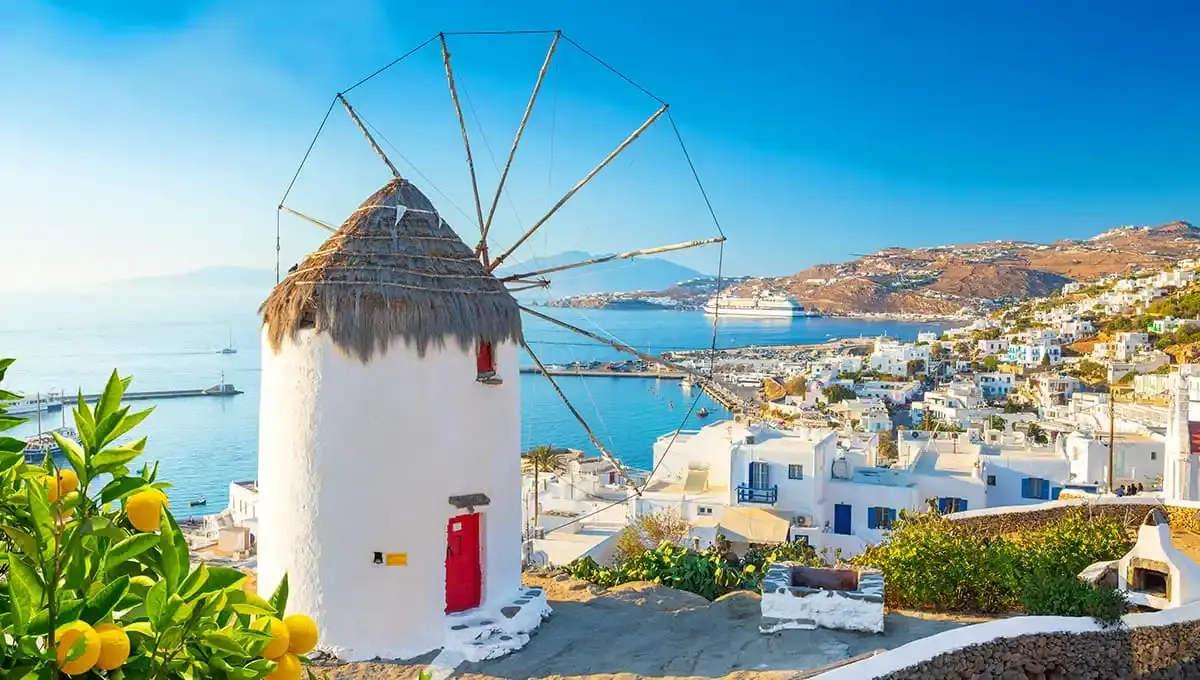
Leave a Reply